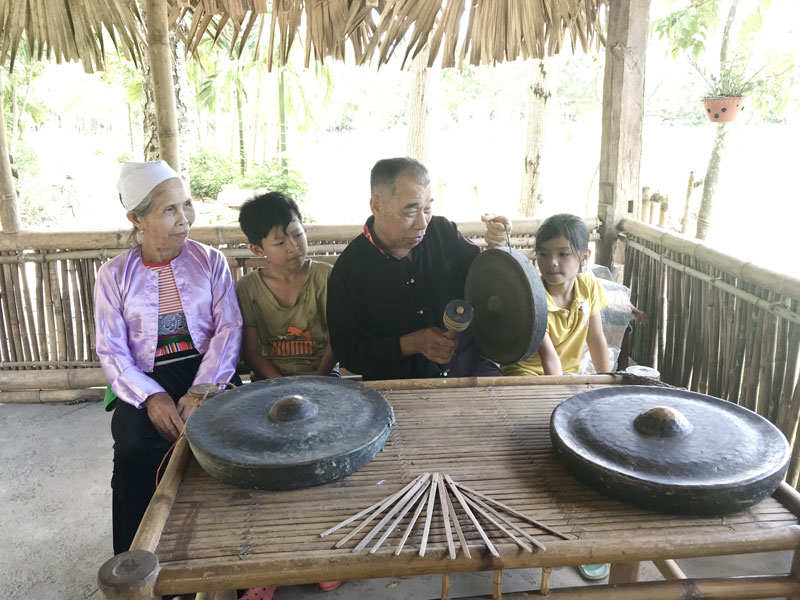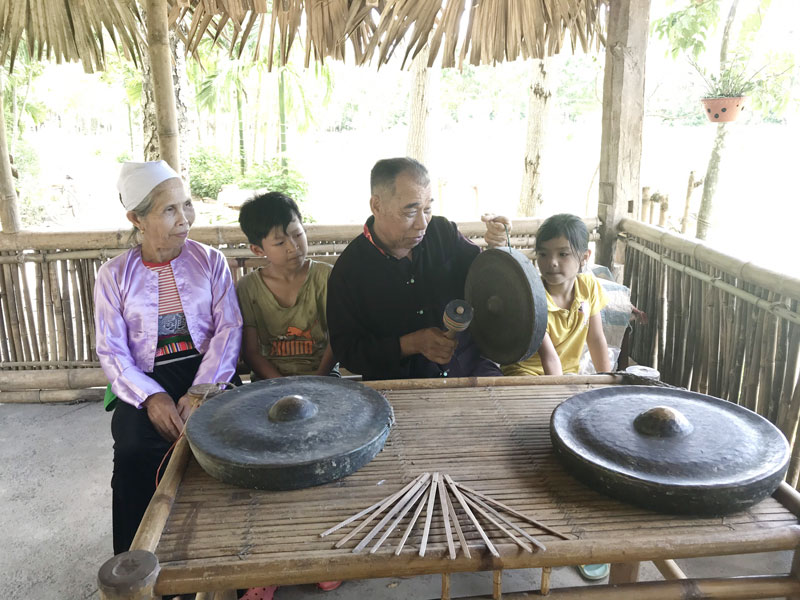


 Mo Muong artist, Mr. Bui Van Khan from
Luy Ai hamlet, Phong Phu commune (Tan Lac) has been keeping a lot of sets of
the ancient gongs, Doi calendars ... passing on to the next generations.
Mo Muong artist, Mr. Bui Van Khan from
Luy Ai hamlet, Phong Phu commune (Tan Lac) has been keeping a lot of sets of
the ancient gongs, Doi calendars ... passing on to the next generations.
Mr. Bui Van Khan, Mo Muong artist, says: "Being born and raised in Muong Bi land is a pride. I myself have always wanted to impart the cultural quintessence and the spiritual values of the People to the next generation, so that they can continue to preserve and promote the values of Muong culture. As a result, the values of the ancestors' roots and thr spiritual culture will be respected, and will last forever and forever with time”.
According to Mr. Khan, his family has a tradition of being Mo Muong, so far it has been the 7th generation being responsible for preserving the culture and the spirituality for the family and Muong ethnic people in Luy Ai village. In the spiritual and religious life of the Muong ethnic people, Mo Muong plays a very important role, performing the spiritual rituals such as going to the fields, groundbreaking, praying for a prosperous and happy life. His Mo songs are indispensable in the rituals of the region. The special thing is that the entire content of the rituals has been passed down by the spoken words from the ancestors, absolutely no notes in books, and the learners must learn them by heart. With his contributions in transmitting the national culture, in May 2019, he was recognized as a Mo Muong artist by the State.
He is not only knowledgeable about the rituals of Mo Muong, the 68-year-old artisan also widely reads and understands a lot. In the old stilt house, which has been passed through many generations, the full features of the ancient architecture, expressing the look of a long-standing culture has been remained. The stilt house is the clearest evidence of the life and customs and practices of Muong ethnic people. In addition, he has also kept many belongings of the ancient Muong people such as gongs, rice pounders, looms, Doi calendars ... He has been teaching his descendants how to use the Doi calendar (made from bamboo sticks) to see the date, seasonality, weather prediction, good and bad days.
Khai Ha is one of the biggest festivals of Muong Bi people, annually held at Luy Ai village's stadium, which is imbued with the cultural identity, arousing the spirit of the national solidarity, so he always motivates the local people to consciously conserve, preserve and promote the traditional values of the festival. Many families have a set of gongs, the old people and children all memorize the gong songs. The folk games such as hitting plates, Sac Bua, Doi singing are still handed down, and they are often held on holidays and New Year.
He is also always at the forefront of the movements of the local emulation. He always takes part in production, encouraging the local people to abolish the backward customs to build a cultural life, helping the local people step by step escape poverty. The outdated and superstitious customs such as inbreeding marriage to keep property, the child marriage, the forced marriage have been eliminated, the cumbersome of sacrifices at costly festivals has been reduced... local Especially, the people have raised their awareness of the environmental sanitation, not keeping animals under the floor of the house, not dumping garbage indiscriminately into streams, making the hygienic latrines, going to medical facilities for medical examination when being sick and there has been no worship ...
Along with the movement of joining forces to build new rural areas, the local people have been improving fields and gardens, preserving the old stilt houses, embellishing them to have clean houses, beautiful gardens, civilized alleys, and the appearance of Muong village in Luy Ai is increasingly changing. In 2014, Muong village in Luy Ai was recognized as a community tourism destination by the province and it has also highly been appreciated by tourists. Many inherent cultural features of the Muong ethnic people have been retained. The contribution of the artisan, Mr. Bui Van Khan in the transmission, preservation and application in the cultural and spiritual life has been recognized by the government and the local people.